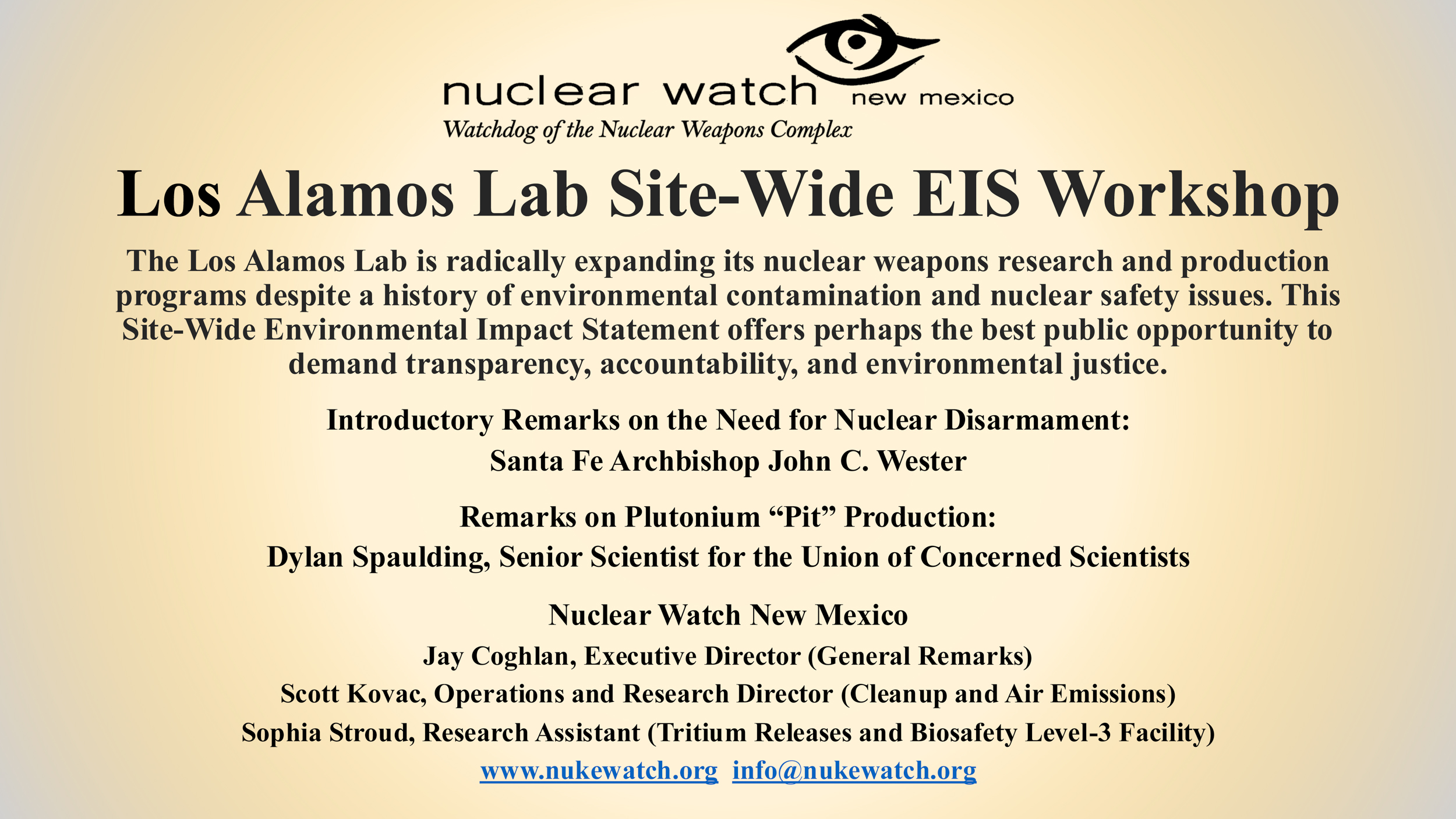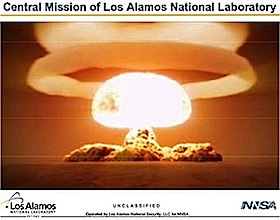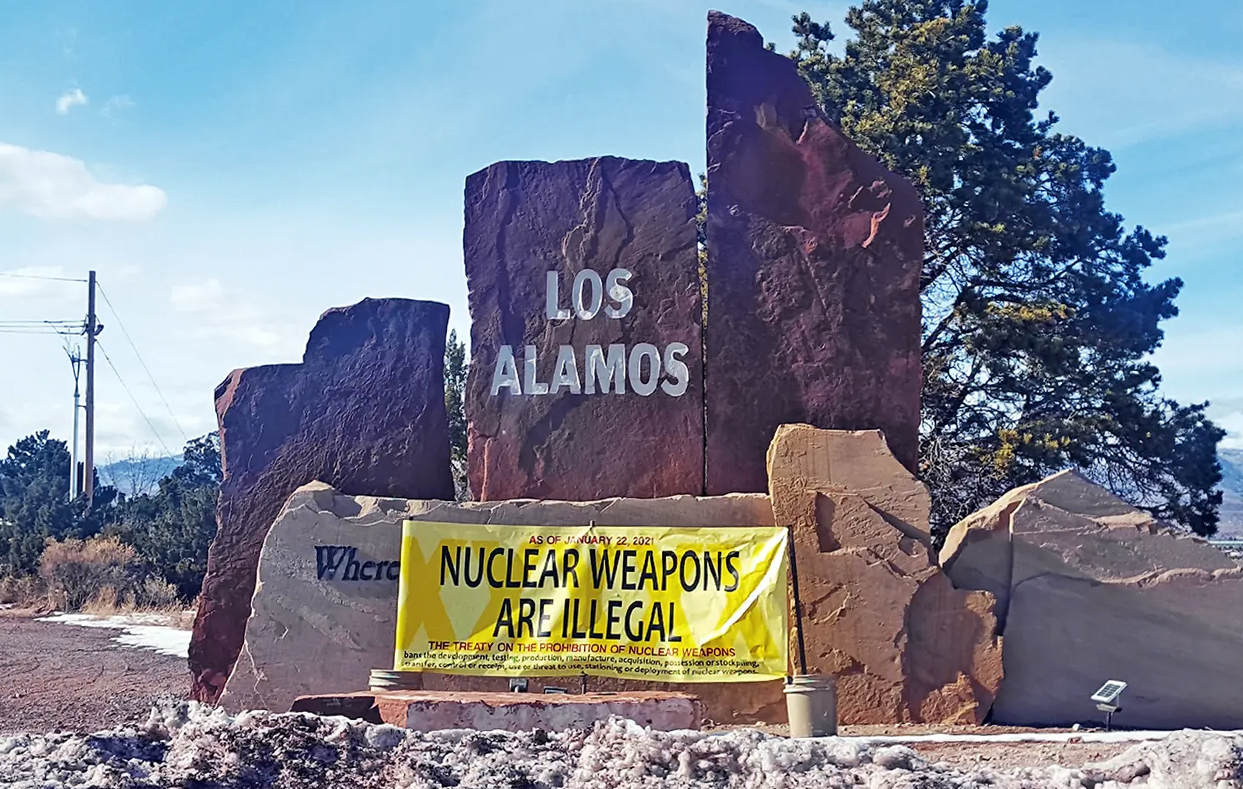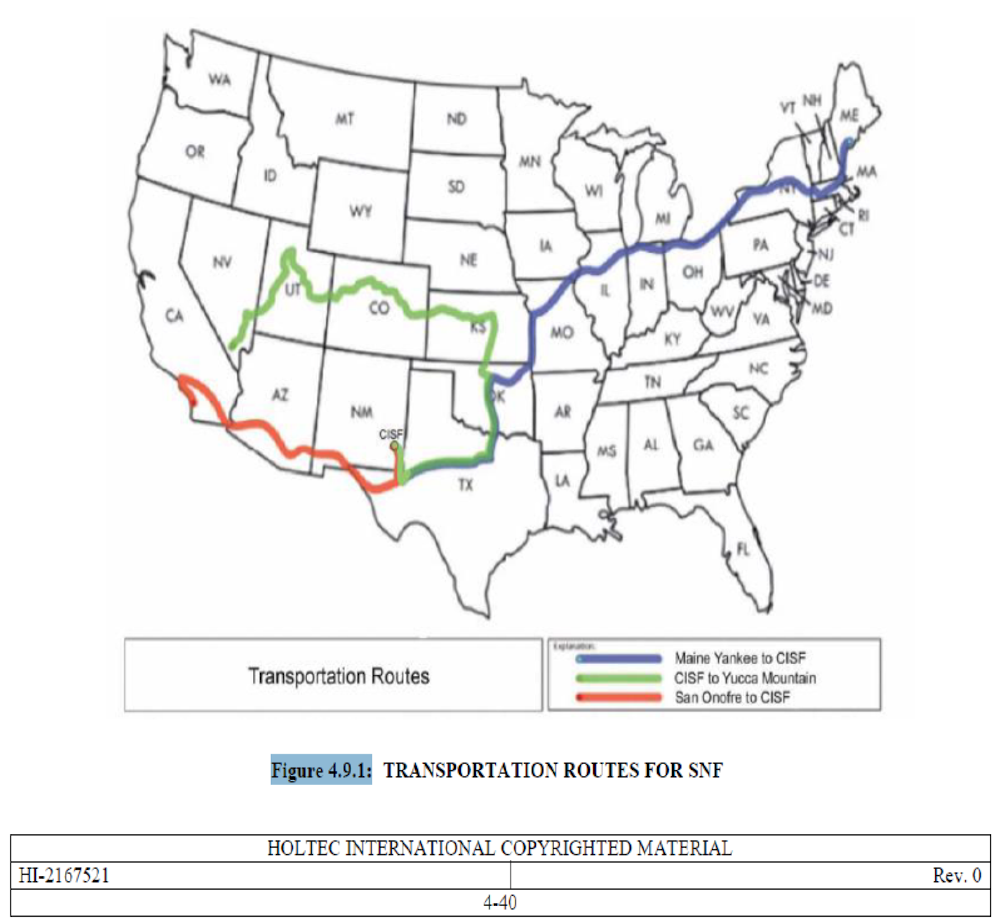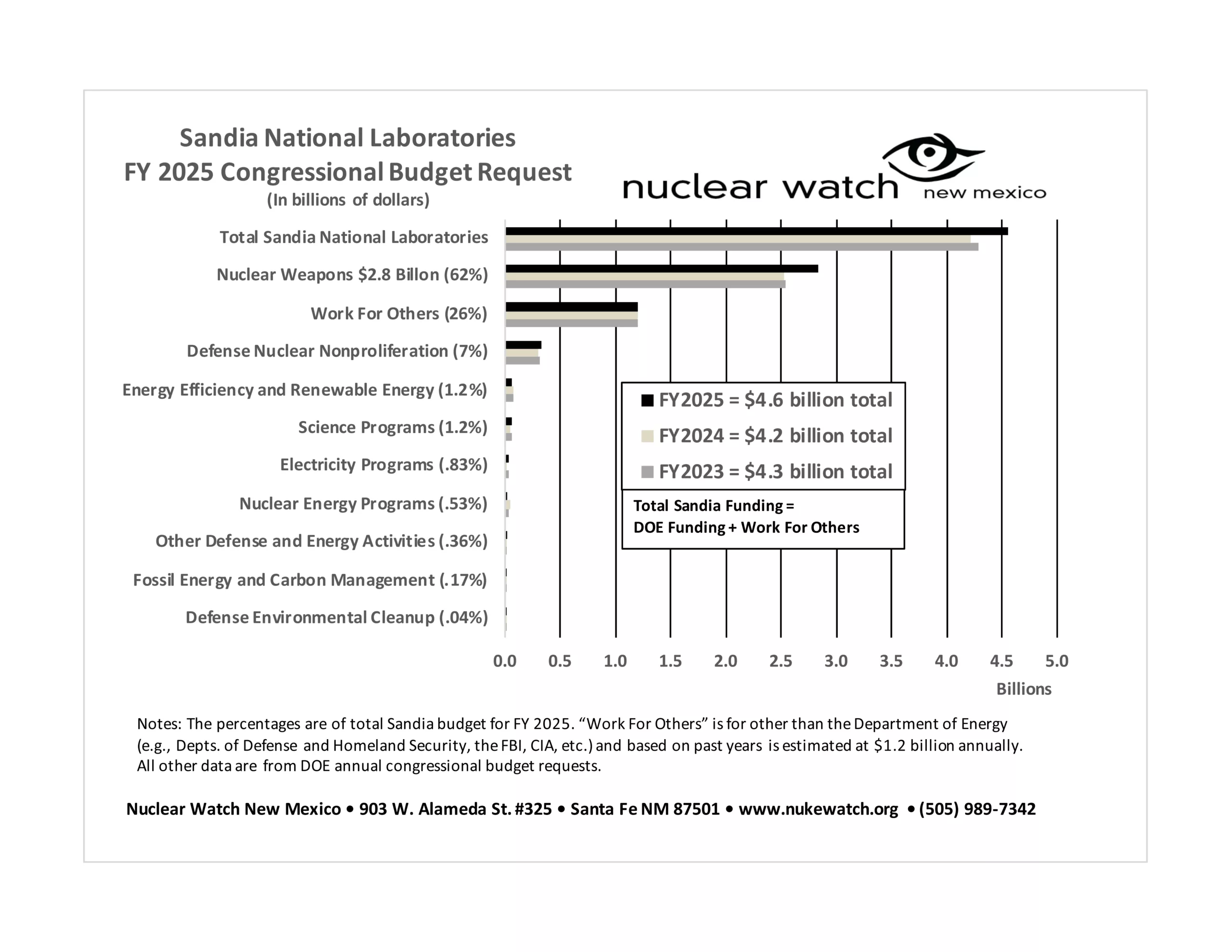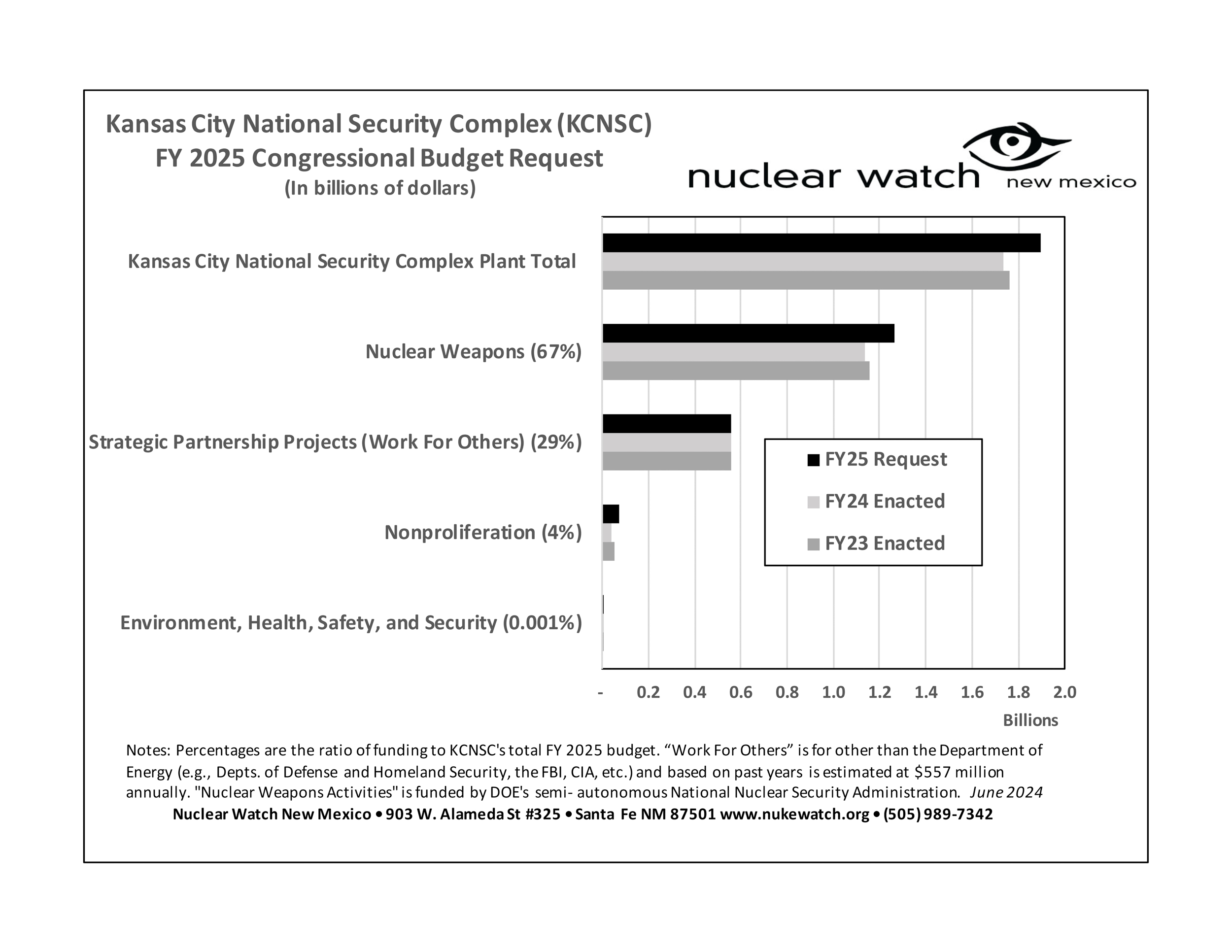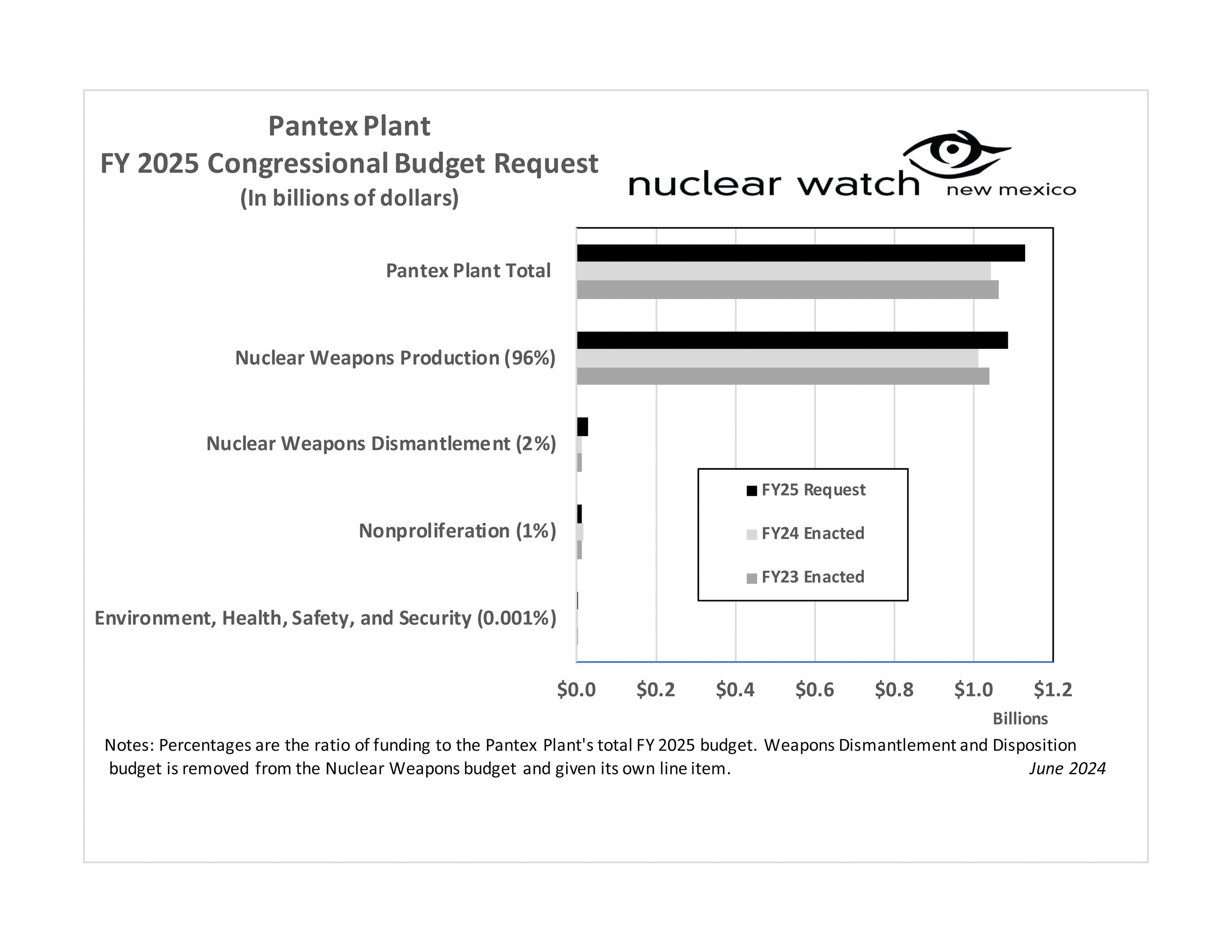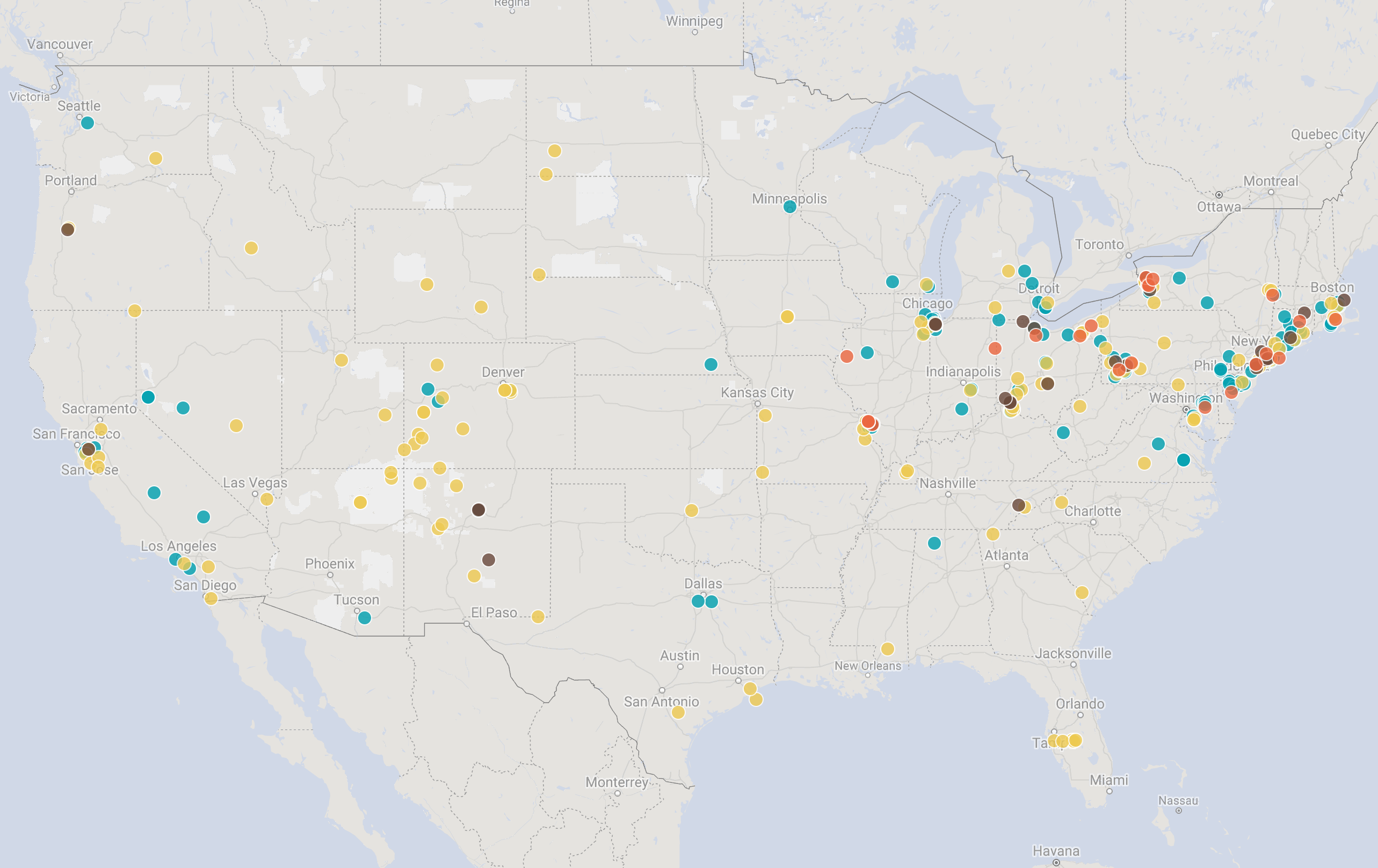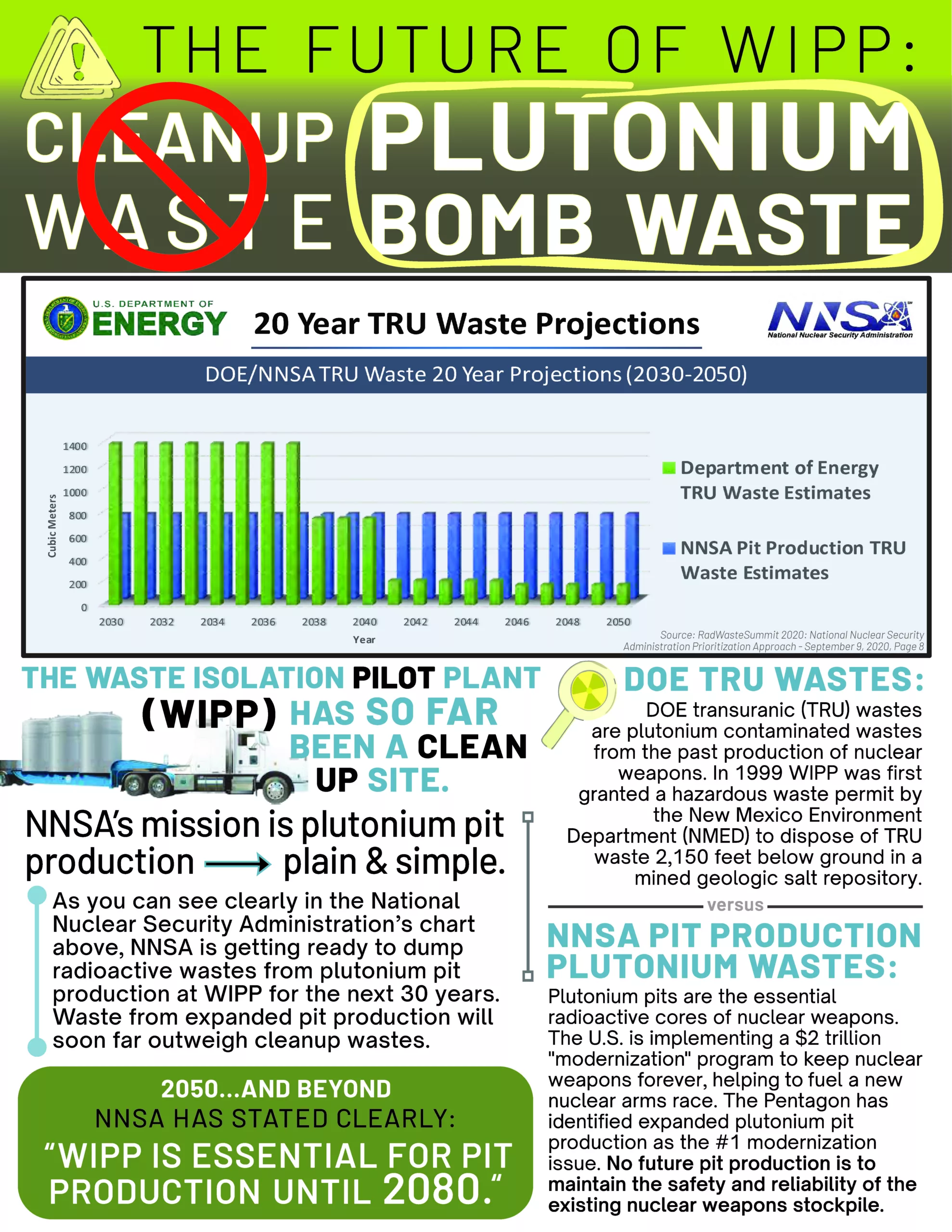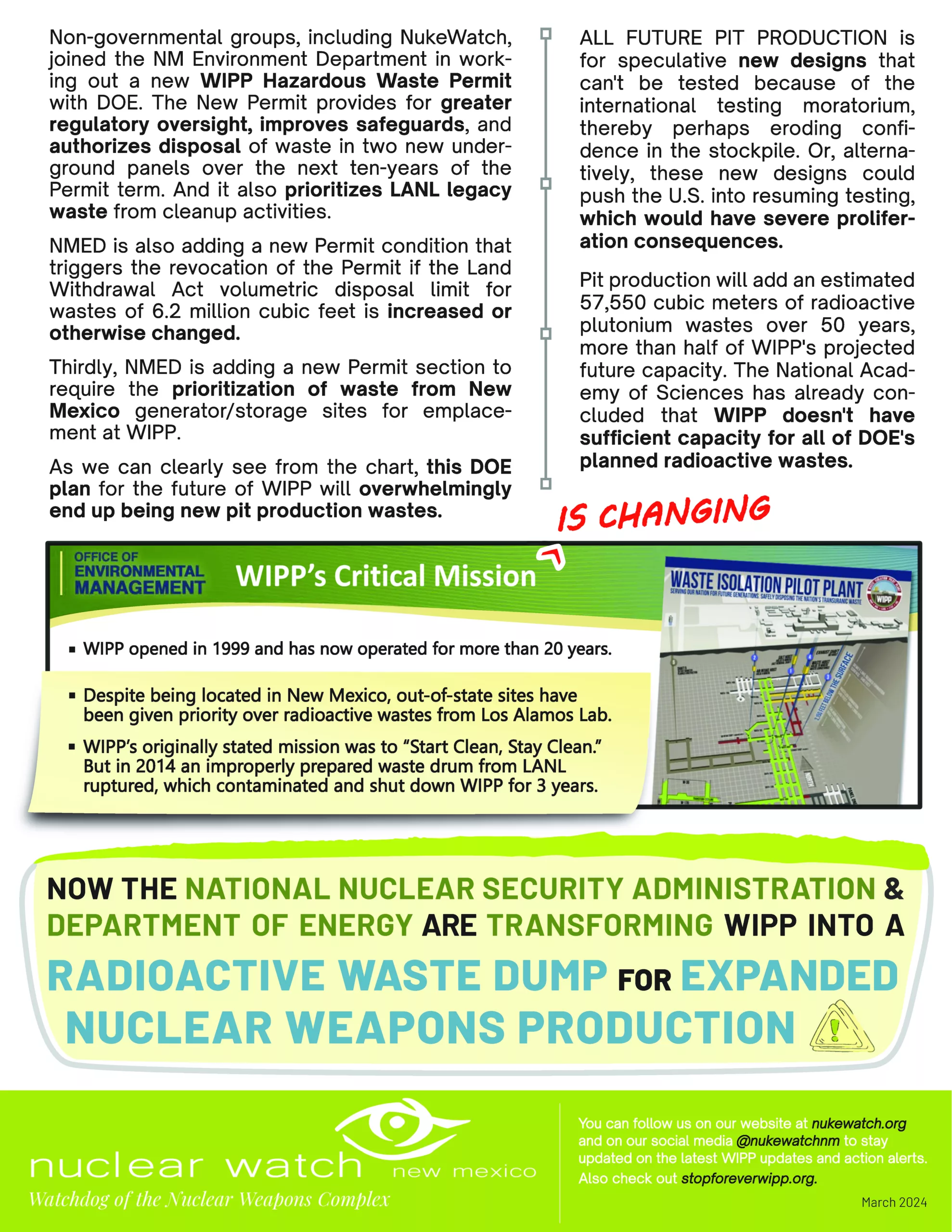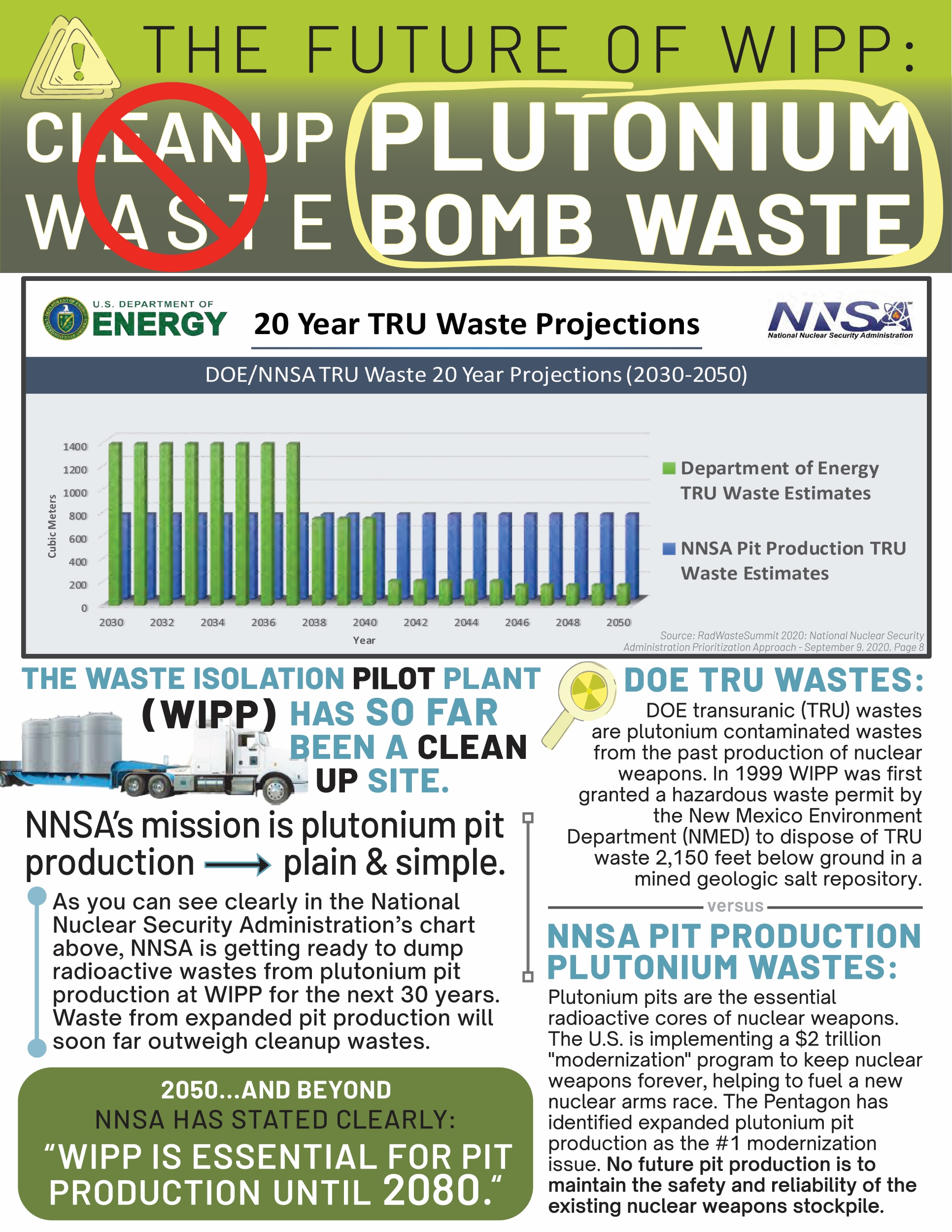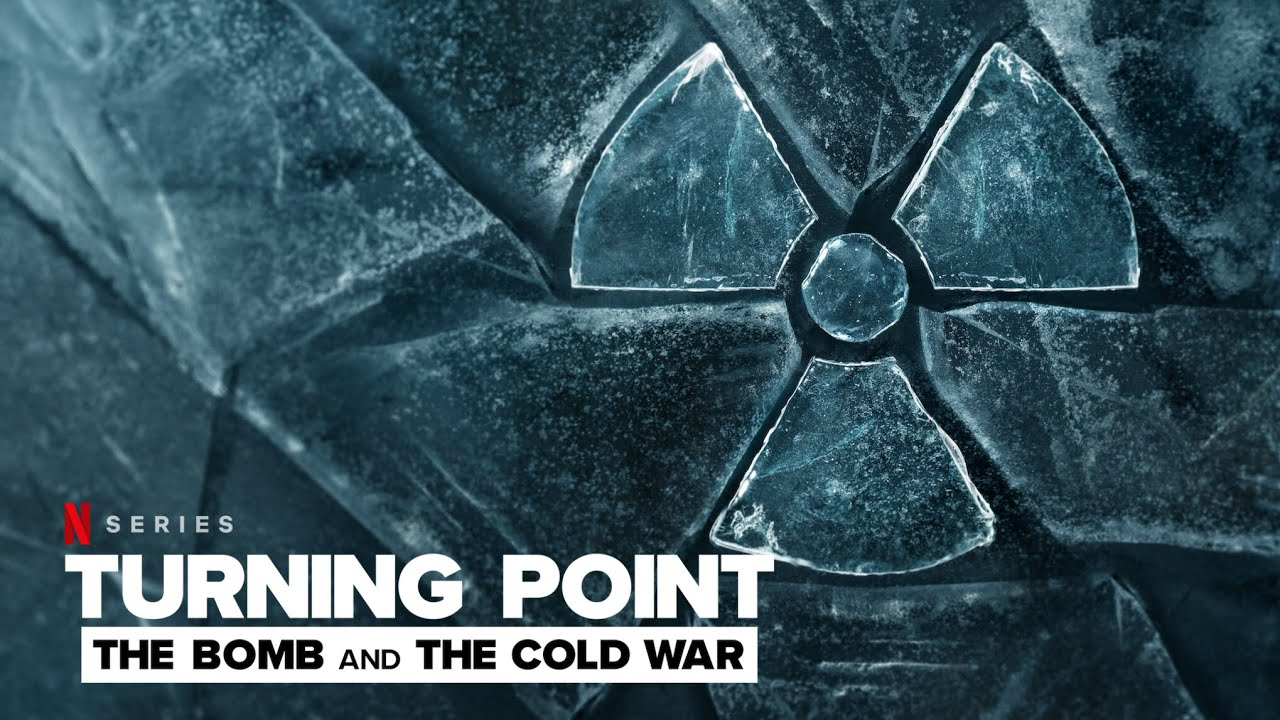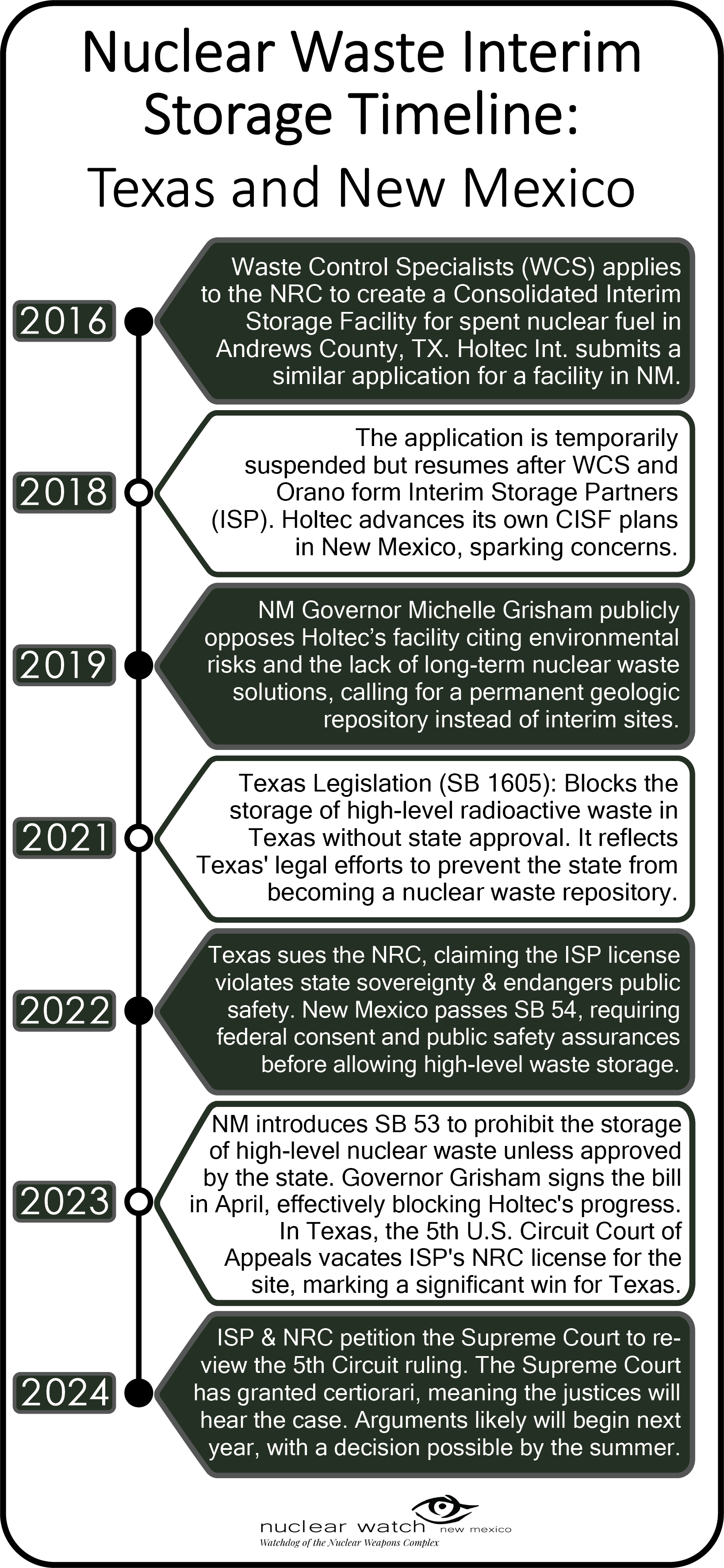QUOTE OF THE WEEK
Nothing Found
It seems we can’t find what you’re looking for. Perhaps searching can help.
LANL’s Central Mission: Los Alamos Lab officials have recently claimed that LANL has moved away from primarily nuclear weapons to “national security”, but what truly remains as the Labs central mission? Here’s the answer from one of its own documents:
LANL’s “Central Mission”- Presented at: RPI Nuclear Data 2011 Symposium for Criticality Safety and Reactor Applications (PDF) 4/27/11
Banner displaying “Nuclear Weapons Are Now Illegal” at the entrance in front of the Los Alamos National Lab to celebrate the Entry Into Force of the Nuclear Weapon Ban Treaty on January 22, 2021
Nothing Found
It seems we can’t find what you’re looking for. Perhaps searching can help.
Follow the Money!
Map of “Nuclear New Mexico”
In 1985, US President Ronald Reagan and Russian President Mikhail Gorbachev declared that “a nuclear war cannot be won and must never be fought.”

Waste Lands: America’s Forgotten Nuclear Legacy
The Wall St. Journal has compiled a searchable database of contaminated sites across the US. (view)
Related WSJ report: https://www.wsj.com
NEW & UPDATED
Los Alamos decontaminating nuclear waste. Could it save space at repository near Carlsbad?
“A report from Nuclear Watch New Mexico posited pit production would generate 57,550 cubic meters of the waste over 50 years, more than half of WIPP’s projected future capacity. This assertion was backed up by a 2019 report from the National Academies of Sciences finding WIPP could lack sufficient space for disposal of surplus plutonium and other DOE planned waste streams in the coming decades.”
By Adrian Hedden, Carlsbad Current-Argus | currentargus.com
Scientists at Los Alamos National Laboratory are hoping to decontaminate some of the nuclear waste from the lab that would otherwise be disposed of at a repository near Carlsbad, as the lab was planning to ramp its production of plutonium pits used to trigger warheads.
Transuranic (TRU) waste from the lab and other Department of Energy facilities is disposed of via burial at the Waste Isolation Pilot Plant in a 2,000-foot-deep salt deposit about 30 miles east of Carlsbad. TRU waste is made up of clothing, equipment and debris irradiated during nuclear research and other activities.
How Annie Jacobsen mapped out ‘Nuclear War: A Scenario’
“There are new players, new nuclear armed nations that are far more unpredictable than those who have had nuclear weapons in the past.”
BY NICHOLAS SLAYTON, TASK & PURPOSE | taskandpurpose.com
It starts with a sudden attack. North Korea, out of paranoia and fear, launches a nuclear strike on the United States, hitting its targets. The United States retaliates with a salvo of its own nuclear missiles. However, in order to hit North Korea, the missiles must pass over Russia. Attempts to communicate with the Russian president fail and Russia’s nuclear warning system makes him think it’s an attack on his country. So he launches his nuclear bombs, this time at the United States.
It’s a global nuclear war. And it happens in minutes.
That’s the setup at the heart of “Nuclear War: A Scenario,” a new book by investigative journalist Annie Jacobsen. The book, released at the end of March, outlines how one attack from an isolated state can set off a chain reaction of nuclear policy, with poor communication and split-second decisions triggering widespread nuclear war. It’s a fictional scena
America’s Nuclear War Plan in the 1960s Was Utter Madness. It Still Is.
We rarely consider the dangers these days, but our existence depends on it.
“‘Humanity is one misunderstanding, one miscalculation away from nuclear annihilation,’ cautions UN Secretary-General António Guterres. ‘We must reverse course.'”
BY ANNIE JACOBSEN, MOTHER JONES | motherjones.com
Nuclear war is madness. Were a nuclear weapon to be launched at the United States, including from a rogue nuclear-armed nation like North Korea, American policy dictates a nuclear counterattack. This response would almost certainly set off a series of events that would quickly spiral out of control. “The world could end in the next couple of hours,” Gen. Robert Kehler, the former commander of US Strategic Command, told me in an interview.
We sit on the razor’s edge. Vladimir Putin has said he is “not bluffing” about the possibility of using weapons of mass destruction should NATO overstep on Ukraine, and North Korea accuses the US of having “a sinister intention to provoke a nuclear war.” For generations, the American public has viewed a nuclear World War III as a remote prospect, but the threat is ever-present. “Humanity is one misunderstanding, one miscalculation away from nuclear annihilation,” cautions UN Secretary-General António Guterres. “We must reverse course.”
So far, we haven’t. The Pentagon’s plans for nuclear war remain firmly in place.
The US government has spent trillions of dollars over the decades preparing to fight a nuclear war, while refining protocols meant to keep the government functioning after hundreds of millions of Americans become casualties of a nuclear holocaust, and the annual budgets continue to grow. The nation’s integrated nuclear war plan in the 1960s was utter madness. It almost certainly remains so today.
Jay Coghlan/NukeWatch NM Letter to the Editor: Santa Fe Reporter March 20, 2024
By Jay Coghlan, The Santa Fe Reporter | sfreporter.com

EFF Designer Hannah Diaz
Cover, March 13: “The Foilies”
THE GREATEST FOILIE OF ALL
The Reporter should stick around in its own back yard for the “The Foilies: Recognizing the worst in government transparency.” IMHO, it’s all small potatoes compared to the National Nuclear Security Administration (NNSA) and the Los Alamos National Laboratory (LANL) with their ~$60 billion program to expand production of plutonium pits, the critical (pun intended) cores of nuclear weapons. NNSA has no credible cost estimates for its most expensive and complex program ever. It has not conducted public reviews as legally required by the National Environmental Policy Act. Pit production will create more contamination and more radioactive wastes. New pits can’t be full-scale tested because of the international testing moratorium, which could erode confidence in stockpile reliability. Worse yet, it could prompt the US to return to full-scale testing, which would have serious global proliferation consequences.
Transparency? NNSA heavily redacts LANL’s “Performance Evaluation Report” on how taxpayers’ money is spent. Years go by before Freedom of Information Act requests are honored. And yet LANL and the NNSA are all too eager to lead us into a new nuclear arms race that could end civilization overnight.
Jay Coghlan
Nuclear Watch New Mexico, Santa Fe
ARCHBISHOP JOHN C. WESTER’S STATEMENT IN SUPPORT OF TRINITY TEST DOWNWINDERS AND URGES PASSAGE OF THE RADIATION EXPOSURE COMPENSATION ACT
ALBUQUERQUE, NM – Monday, March 18, 2024– IMMEDIATE RELEASE – The following is a message from Most Reverend John C. Wester, Archbishop of Santa Fe, and Anne Avellone, Director, Office of Social Justice and Respect Life and Archdiocese of Santa Fe Justice, Peace, and Life Commission:
“Oppenheimer,” a movie released in 2023, many parts of which were filmed in New Mexico, is an expansive biopic of the life of Robert Oppenheimer and his work developing the first atomic bomb at Los Alamos, NM and detonating it in the Tularosa Basin at the Trinity site. On March 10, 2024, the movie received seven Academy Awards, including for Best Picture. We are grateful the movie raises awareness of the life and work of Robert Oppenheimer and, in doing so, brings to new audiences an awareness of the development of the atomic bomb and its perils.
However, we recognize the very real and lasting impact of the development and testing of the atomic bomb has had serious and often deadly health impacts on the people of New Mexico and throughout the country. People like uranium miners and the Downwinders of New Mexico are unwitting victims who had no choice in being exposed to radiation. It is unfortunate that such a remarkable and timely film does not acknowledge these realities.
The very same week “Oppenheimer” received so many accolades in the motion picture world, the U.S. Senate passed by a vote of 69 to 30 a bipartisan reauthorization of the Radiation Exposure Compensation Act (RECA), which compensates people who have had health issues due to radiation exposure from the atomic testing and uranium mining.
Continue reading
NNSA’s Nuclear Weapons Budget Takes Huge Jump
Arms Race Accelerates with MIRVed Warheads
Los Alamos Lab Cleanup Cut
Ironically the day after the film Oppenheimer was awarded multiple Oscars, the Department of Energy’s semi-autonomous National Nuclear Security Administration (NNSA) asked Congress for its biggest nuclear weapons budget ever. NNSA’s FY 2025 request for “Total Weapons Activities” is $19.8 billion, $700 million above what Congress recently enacted for FY 2024. It is also a full billion dollars above what President Biden asked for last year, which Congress then added to and will likely do so again.
The Biden Administration states that the $19.8 billion will be used to:
“[P]rioritize implementation of the 2022 National Defense Strategy and Nuclear Posture Review by modernizing the Nation’s nuclear deterrent to keep the American people safe. The Budget supports a safe, secure, reliable, and effective nuclear stockpile and a resilient, responsive nuclear security enterprise necessary to protect the U.S. homeland and allies from growing international threats.” whitehouse.gov/wp-content/uploads/2024/03/budget_fy2025.pdf, page 75.
The 2022 National Defense Strategy and Nuclear Posture Review for the first time posited two nuclear “near peers”, i.e. Russia and China, that need to be simultaneously “deterred.” This hinted at a potentially large nuclear buildup which this budget may now be implementing. That claimed need to deter two nuclear near peers was explicitly taken a step beyond just deterrence in an October 2023 report from the Strategic Posture Commission. It declared:
“Decisions need to be made now in order for the nation to be prepared to address the threats from these two nuclear-armed adversaries arising during the 2027-2035 timeframe. Moreover, these threats are such that the United States and its Allies and partners must be ready to deter and defeat both adversaries simultaneously.” ida.org/research-and-publications/publications/all/a/am/americas-strategic-posture, page vii (bolded emphasis added)
NNSA’s Nuclear Weapons Budget Takes Huge Jump
Arms Race Accelerates with MIRVed Warheads
Los Alamos Lab Cleanup Cut
FOR IMMEDIATE RELEASE, March 11, 2024
Jay Coghlan – 505.989.7342 | Email
Santa Fe, NM – Ironically the day after the film Oppenheimer was awarded multiple Oscars, the Department of Energy’s semi-autonomous National Nuclear Security Administration (NNSA) asked Congress for its biggest nuclear weapons budget ever. NNSA’s FY 2025 request for “Total Weapons Activities” is $19.8 billion, $700 million above what Congress recently enacted for FY 2024. It is also a full billion dollars above what President Biden asked for last year, which Congress then added to and will likely do so again.
The Biden Administration states that the $19.8 billion will be used to:
“[P]rioritize implementation of the 2022 National Defense Strategy and Nuclear Posture Review by modernizing the Nation’s nuclear deterrent to keep the American people safe. The Budget supports a safe, secure, reliable, and effective nuclear stockpile and a resilient, responsive nuclear security enterprise necessary to protect the U.S. homeland and allies from growing international threats.” whitehouse.gov/wp-content/uploads/2024/03/budget_fy2025.pdf, page 75.
The 2022 National Defense Strategy and Nuclear Posture Review for the first time posited two nuclear “near peers”, i.e. Russia and China, that need to be simultaneously “deterred.” This hinted at a potentially large nuclear buildup which this budget may now be implementing. That claimed need to deter two nuclear near peers was explicitly taken a step beyond just deterrence in an October 2023 report from the Strategic Posture Commission. It declared:
“Decisions need to be made now in order for the nation to be prepared to address the threats from these two nuclear-armed adversaries arising during the 2027-2035 timeframe. Moreover, these threats are such that the United States and its Allies and partners must be ready to deter and defeat both adversaries simultaneously.” ida.org/research-and-publications/publications/all/a/am/americas-strategic-posture, page vii (bolded emphasis added)
Tribes Meeting With Inter-American Commission on Human Rights Describe Harms Uranium Mining Has Had on Them, and the Threats New Mines Pose
As spiking uranium prices drive a surge of proposals for new mines, the Navajo Nation joined the Ute Mountain Ute, Havasupai, Northern Arapaho and Oglala Sioux tribes in a commission hearing with federal officials to push back against mining on and near their lands.
By Noel Lyn Smith, Inside Climate News | insideclimatenews.org

Members of five tribes told the Inter-American Commission on Human Rights that Indigenous communities in the United States continue to suffer from the legacy of uranium mining and will face a persisting threat if new proposals for uranium extraction in the West are authorized during a hearing on Feb. 28 about mining to support the nation’s nuclear industry.
“The U.S. has rarely, if ever, secured tribal consent for uranium production on and near tribal lands,” Eric Jantz, legal director of the New Mexico Environmental Law Center, said. “The cost of the government’s lopsided policies have disproportionately fallen on Native communities.”
The Inter-American Commission on Human Rights is an organ of the Organization of American States. Its mission is to promote and protect human rights in member states, including the U.S.
Members of the Navajo Nation, Ute Mountain Ute Tribe, Havasupai Tribe, Northern Arapaho Tribe and Oglala Sioux Tribe requested the hearing to tell commissioners about the ramifications of uranium mining on their communities and the inadequate communication and response by the U.S. government, Jantz explained.
“Turning Point: The Bomb and the Cold War” Explores Impact of US–Soviet Conflict
The nine-part doc examines how two global superpowers have irrevocably altered the course of history.
By Roxanne Fequiere, Netflix | netflix.com
While the the Cold War ended in 1991, even a casual appraisal of current headlines reveals that relations between the United States and Russia — the one-time center of the Soviet Union — remain tense, to say the least. The global repercussions of the Cold War continue to ripple through the current geopolitical landscape to this day, but it can be difficult to understand just how a mid-20th century struggle for ideological dominance continues to ensnare countless nations in ongoing unrest.
NEW YORK TIMES OPINION SERIES ON THE THREAT OF NUCLEAR WEAPONS IN AN UNSTABLE WORLD
An Introduction: It’s Time to Protest Nuclear War Again
By Kathleen Kingsbury, Opinion Editor, New York Times | nytimes.com
The threat of nuclear war has dangled over humankind for much too long. We have survived so far through luck and brinkmanship. But the old, limited safeguards that kept the Cold War cold are long gone. Nuclear powers are getting more numerous and less cautious. We’ve condemned another generation to live on a planet that is one grave act of hubris or human error away from destruction without demanding any action from our leaders. That must change.
ACTION ALERTS
Nothing Found
It seems we can’t find what you’re looking for. Perhaps searching can help.
CRITICAL EVENTS
Nothing Found
It seems we can’t find what you’re looking for. Perhaps searching can help.
Nothing Found
It seems we can’t find what you’re looking for. Perhaps searching can help.
New Nuclear Media: Art, Films, Books & More
“In Our Hands” – The academy award nominated film documenting the largest protest in US history, calling on the government to end the nuclear arms race.
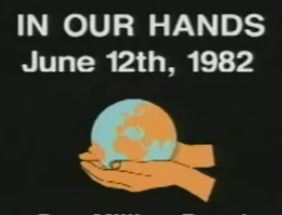 Robert Richter’s IN OUR HANDS is about a magical day, June 12, 1982, when one million people took to the streets of New York to peacefully protest for an end to the nuclear arms race. It remains the largest single peace demonstration in US history.
Robert Richter’s IN OUR HANDS is about a magical day, June 12, 1982, when one million people took to the streets of New York to peacefully protest for an end to the nuclear arms race. It remains the largest single peace demonstration in US history.
A September 11th Catastrophe You’ve Probably Never Heard About
In 1957, America narrowly averted a nuclear meltdown at the Rocky Flats plant in Colorado. A new book explores how close we all came to disaster.
ANDREW COHEN | theatlantic.com
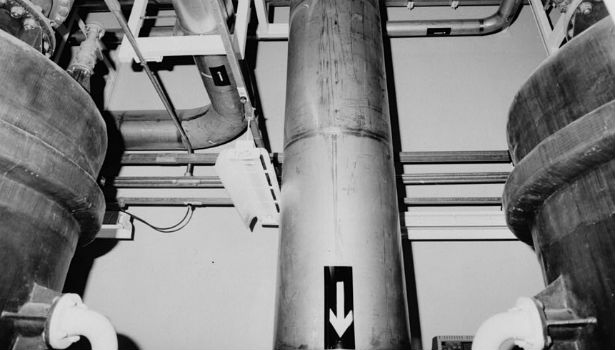
Nothing Found
It seems we can’t find what you’re looking for. Perhaps searching can help.



